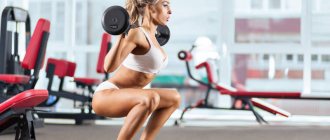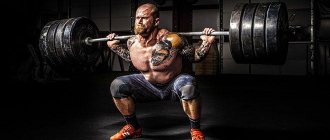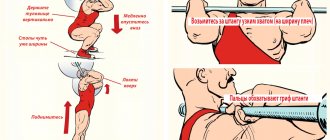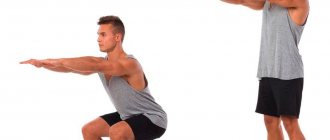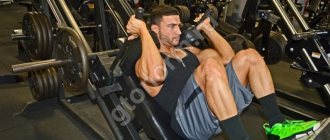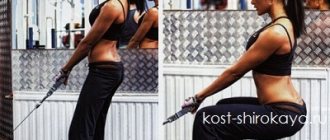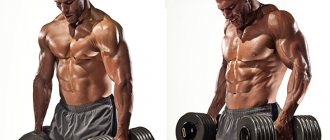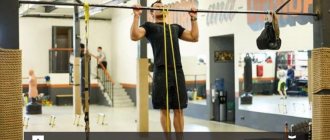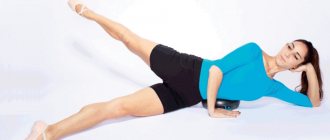Recently they have begun to say that barbell squats are not necessary. Indeed, it is easier to tell a beginner that his destiny is extension and flexion in the machine, and some kind of leg press, than to explain the technical nuances of this basic exercise, systematically work on strength and flexibility, set technique, monitor the body, the work of the knees, shins, hips, do not allow the pelvis to “peck”. In fact, the squat is available to everyone who has no contraindications to bending the knee, ankle and hip joints, and no contraindications to axial load on the spine. The movement is performed in all sports, and in fitness there is a place for a good technically correct squat, and not just half squats with a body bar.
Working muscles
The load is evenly distributed between the long back muscles, quadriceps, buttocks, hamstrings and calves. The abdominal muscles, deltoids, and latissimus muscles work as stabilizers. It is sometimes believed that the long back muscles also stabilize in the squat, but the actual situation depends on technique. If an athlete is long-legged and has a long thigh, the natural forward tilt of the back will be compensated by the work of the long back muscles.
Why is the squat called the king of exercises?
We have already noted that the exercise is considered basic due to the fact that several muscle groups are involved in the work. Squats are a heavy lifting exercise that uses free weights. Testosterone enters the blood intensely (especially during critical load on the body) - this is the reason for the increase in weight. In total, about 250 muscles are involved in the exercise. Let's list the main ones:
- quadriceps femoris;
- gluteal (large, medium and small);
- back;
- back of the thigh;
- leg muscles;
- abdominal planks.
On a note! By the way, about the legs. The exercise allows you to strengthen the tibialis anterior, peroneal, gastrocnemius and soleus muscle groups. Experienced trainers will tell you about stabilizing the lower back and back. Of course, with proper technology.
Benefits of Exercise
For a fitness specialist, the main advantage is the opportunity to work out maximum muscles in a minimum of time. The truth is harsh - a person who does, for example, 4 working sets of squats of 8-10 repetitions with a relatively high weight, pumps up his abs and goes home or to work will be better built than his friend who hangs out in the gym for an hour and a half, but only does flexion and extension, and, at most, some platform leg presses.
For athletes and advanced amateurs, the squat is good because:
- Builds overall lean body mass . The back also grows from squatting, it’s not for nothing that experienced people will always identify someone who is lying about their working weights on the Internet precisely by the appearance of their “pillars” (long back muscles);
- Allows you to work more powerfully with your legs in all sports disciplines . MMA fighters and boxers, track and field athletes and football players squat with a barbell. Yes, they don’t lift the same weights as powerlifters, but they do this exercise to build power in the off-season. Plus, power squats are a key way to prevent injuries;
- Changes the shape of the hips and buttocks . In "old school" bodybuilding there is no leg training for a healthy person without squats. Lunges and platform presses are auxiliary exercises, squats are the main ones;
- Serves as an indicator of overall strength . Although pure strength is mostly tested, it is only useful to know it in powerlifting competitions. And exercises like the leg press are not indicators of strength, since they do not work the core muscles;
- Improves health , including blood circulation in the pelvic organs, and increases bone strength;
- Increases energy expenditure during training, helps burn fat and build muscle
Opinions differ regarding the benefits of squats for beginners and exercise enthusiasts. Objectively, squatting with minimal weights improves coordination of movements, increases joint mobility and strengthens ligaments. It does not contribute to injury if performed smoothly and under control. Opponents of beginner squats argue that such people's muscles are too weak to support the weight on their back and perform the movement technically correctly. In fact, it makes sense to give a short period of “pumping up” the muscles in the machines before squats, but it’s not worth delaying it for 4-5 months, as some trainers do, so as not to teach beginners the technique. The problem with beginners and amateurs is precisely the lack of skill and low joint mobility. The easiest way to do this is by squatting.
Contraindications
Before we tell you how to properly squat with a barbell for men and women, we will introduce you to a list of contraindications. Read it very carefully:
- Any, even minor, problems with the spine;
- Diseases or injuries of the hip or knee joints, ligaments;
- Dorsal and abdominal hernias;
- Radiculitis and scoliosis;
- Acute diseases of the cardiovascular system;
- Conditions after a heart attack or stroke;
- Varicose veins;
- Glaucoma;
- Pregnancy;
- Recovery period after surgery or injury;
- Any exacerbation of chronic diseases;
- Inflammatory processes, increased body temperature;
- Bad feeling.
Execution technique
Beginners begin to learn the exercise from a squat to a box below the parallel of the femur with the floor. They perform the movement without a barbell, with a weight held at the chest, or with a body bar on the shoulders. As soon as a person acquires the skill of squatting with a straight back, without “unwinding” the lumbar region at the bottom of the exercise, and without bending too much forward, he can begin to be taught a classic squat with a barbell.
Before approaching even the minimum weight, you need to tune in and “scroll” the sequence of actions in your head. There is no need to run under the bar as quickly as possible and remove it at random, even if there is a line in the gym for the apparatus. Concentration in squats is the key to avoiding injury.
It's BAR SQUATS, baby!
Performing squats
- The bar is installed at the height of the athlete's collarbones, or slightly lower. You need to come up, stand under the barbell in one movement and place it on the lower part of the trapezius muscle. In fitness, it is better to avoid squats with the bar positioned on the top of the trapezius. They are quite traumatic for the cervical spine, and a novice athlete cannot always carefully remove and place the barbell from the racks, which is why he injures his neck;
- The grip should be slightly wider than shoulder-width, but stable, so that your hands do not slip towards the plates. Wider grips are allowed if shoulder mobility is lacking, but loss of balance must be avoided. The back should be tense and arched, that is, the shoulder blades are brought to the spine and lowered, but the abs are tightened and compensate for the natural lordosis. You should not throw your tailbone up; if such a movement occurs naturally, you need to tense the front surfaces of your thighs and “tilt” your pelvis forward so that the pelvic bones begin to point straight forward;
- The neck is level. The feet are on the same line under the bar, the bar is projected onto the middle of the arch of the foot, the knees are slightly bent. In one motion, the athlete extends both knees and lifts the barbell above the racks;
- Then you need to pull your stomach inward to stabilize, make sure the bar is lying flat, and take three steps - right foot back, left foot to right, and feet shoulder-width apart or slightly wider. Socks are turned to the sides, not forward. Do not squat with a barbell with parallel feet. If you need this particular version of the squat, it is better to fix your shin in a special machine and hold the weight in front of you;
- Next, the athlete makes sure that his back is slightly tilted forward, his shoulder blades are pulled together and lowered, his abs are tightened, he inhales, and begins to spread and bend his knees towards his toes. There is no need to make any movements of the pelvis. And even more so, you should not reach back, sit on an imaginary chair, etc. The energy from bending the knees and shins is enough for the hip joints to work in the plane intended for them by nature, and not the plane imagined by novice bodybuilders. On the contrary, during a squat you need to monitor the “rotation” of the pelvis and the tilt of the back. The first must be absent, and the second must be minimally acceptable. Only tall people with a long thigh squat in a “fold”, that is, initially with a tilted back, they have no other anatomical option;
- You need to squat not until the thigh is parallel to the floor, but until the pelvic bones go below the top of the kneecap. Contrary to popular belief about “the safety of the parallel squat for the knee,” the peak load in the parallel technique falls on the anterior cruciate ligaments. If you sit a little lower, the load will be evenly distributed between the hip, ankle and knee joints, and the ligaments will not be damaged;
- As soon as the touch is achieved, you need to push off powerfully with your legs and begin to straighten your knees and rise. Back movements in fitness should not be performed on small and medium weights. Similarly, you should avoid shifting your center of gravity to your toes;
- There is no need to squat quickly. You should return your back to its original position and control your abs before each repetition;
- When all the repetitions are completed, you need to go to the racks and, by bending both knees, return the barbell to them.
Efficiency Tips
- There is no need to remove and lower the barbell “in scissors,” that is, in a lunge position. With the working weight, the athlete can swing forward or to the side, and he will fall;
- A low bar squat is allowed, but not the “bar over the shoulder blades” position. This is sometimes given to girls to “load their buttocks.” Fans of loading the buttocks can do any bending with a barbell or a gluteal bridge after squats, but breaking the shoulder joints for the sake of a ghostly shift in emphasis is not worth it. Moreover, for most people, an extremely low bar means an equally significant tilt of the body forward;
- Advice from illiterate amateurs regarding moving the pelvis back and maintaining a depth below parallel is mutually exclusive. If a person takes something there, he will only reach it by “pecking with the pelvis”, or in a position where the body lies on the hips. Therefore, you need to clearly decide for yourself. If there are no injuries that prevent you from squatting, you should squat deeply, due to the movement of your knees and without moving your pelvis back. If they exist, it is worth discussing with your trainer options for replacing the squat with another multi-joint movement for the lower body;
- Bringing your knees past your toes in a squat is not dangerous, or rather, it is a necessary condition for a squat for people with long thighs. It is dangerous to squat with your kneecaps straight forward with your feet parallel. Socks should be turned out as far as the hip joint allows, all other options are not acceptable;
- But the placement of the feet wider than the anatomical width that the hip joint allows is also dangerous. This can cause injuries to the joint that takes the longest to recover, and even stretching of the adductor muscles as an unpleasant addition;
- The width of a squat “for health” is determined simply. The athlete is forced to make a high jump and land at a comfortable width. The placement of your feet upon landing will determine the possible width of your stance. It is allowed to move your legs 2-3 cm outward or inward, but do not “turn” them to the sides for the sake of a ghostly desire to pump up your buttocks. By the way, a wide squat, in addition to the buttocks, does a good job of growing the adductor muscles of the thigh, so those who like large pelvises and thin legs will not get what they want here
Warm-up is the most crucial moment. Just running and pedaling is the most useless way to warm up before a squat. Cardio is done for no more than 5 minutes, then a series of glute bridges with support on a bench is performed without weights, a series of lunges with the right and left legs, and several sets of squats without weight. Then, from an empty bar, they rise to the working weight from approach to approach, increasing the weight. The step is individual.
Leg exercises. Squats.
Nuances and tips for performing squats with a barbell
Let's consider several important nuances when performing squats with a barbell.
Selection of projectile weight
There is a rule that must be followed when selecting weights: to build muscle mass, you will need 6-13 repetitions for each approach, and the last two times should be done on failure.
Let’s say that 10 repetitions per set is enough for a beginner athlete. First you need to perform the correct technique with a weight of 50 kg, if failure occurs on the 8th repetition, then everything is correct. If all 10 reps were easy, then this is not your working weight, you need to add another 5 kg on each side. Thus, by increasing the weight, failure should occur on the 8th rep.
Barbell movements
Movements with the barbell must be carried out carefully and without strain; it is important to keep your back straight and not bring your knees beyond the line of your toes at the bottom of the squat, otherwise your knees will be injured.
The barbell is placed just above the collarbones, you need to go up and in one movement stand under it, place it on the lower part of the trapezius muscle. The main thing is not to rush and do everything very carefully.
Breathing while doing the exercise
If the squat is done with a small weight, then you need to breathe smoothly and evenly. Don't hold your breath. Inhale as you lower into the squat and exhale as you come out of it.
For heavy weights you need to use a special technique. Before starting the squat, inhale 80% of the maximum and hold it. Then sit down while holding your breath and exhale only at the very end, when you get up. This creates pressure in the peritoneum and protects the spinal column from heavy load on it.
How to determine the number of squats in a set
In general, there is no ideal number of repetitions that must be done in training. Beginners should start with 8-13 repetitions, and then optimize their number: increasing or decreasing, focusing on their feelings.
The main thing for effectiveness is to choose the right weight for the exercise.
Is insurance required?
Very often, beginners, when they find themselves in the gym for the first time, are embarrassed to ask for help from a coach. There are many places where you can do without insurance, but in the squat with a barbell it is very necessary! Especially when working with heavy weights.
Never work with a barbell alone - it's dangerous!
If squats are performed in a rack, then you can install limiters that will help you rise and take on the weight of the barbell if the athlete himself cannot.
What to do if the squat is not in the rack? It's simple. You need to ask for help from a strong guy who will stand behind you and provide backup during the exercise. As soon as the athlete gets tired and cannot get up, he will pick up the barbell. Insurance is especially needed on the last repetitions, which makes the training most effective.
Should you include exercise in your daily routine?
To grow muscle mass, you need to perform from 5 to 15 approaches per week. Thus, you can squat with a barbell 2-3 times a week for 5-7 approaches. It is important to alternate types of squats: sumo, overhand, front and back. This will pump each muscle group evenly and reduce the load on the spine.
How to choose weight
Some exotic methods of selecting weights are not for squats. This is not a failure exercise, at least not until the person can control his or her body position in any state of fatigue. Repetitions are done from 3 to 12, sometimes more, this is determined by the level of the athlete and the purpose of the training.
Otherwise, follow the rules:
- The last 2 repetitions should be difficult, but for the purposes of health-improving physical education, “work” is not the hellish bending of the back forward, knees drawn inward, and lifting the pelvis upward. This is a tangible resistance of the muscles to the load, that’s all;
- You should always start with an empty bar, then move in steps from 5 to 10 kg, up to the working weight;
- It is possible to perform with different weights on different days, since recovery after training is not linear;
- Once you reach the level of “squatting your own weight” for women, and “squatting 1.5 times your weight” for men, periodization is required, that is, cycling light and heavy workouts, even if you squat once a week
How deep should you squat?
Stopping flexion is, as you remember, one of the controversial issues.
Let's say goodbye to the myth about the dangers of full squats. A healthy person who has no contraindications in the hips, knees or spine is able to withstand this exercise without harming himself. You can squat a quarter, a half, or a full depth with ease, as Powers and Salem proved in 2002. The research results are published in J Orthop Sports Phys Ther (32nd issue) on pages 141-148. The only issue to consider is the vertical external load. We are talking about axial pressure and the position of the pelvis. Pressure on the spinal discs occurs in athletes who lift weights three times their own. But the pelvis at certain angles of inclination makes the spine round, which is also not good. Therefore, the limits of flexion are selected by the coach individually, taking into account the physical capabilities of the athlete.
Impact on the lower back and knees
Injured athletes and people with hyperlordosis should be conscious about squat training. Many people should not perform squats, at least until full recovery has been achieved.
The movement itself is not dangerous to the lower back and knees, and with weights no greater than your own can be performed without benders, bandages, or a belt.
To prevent injury, you need to pay attention to:
- Press work . The stomach should not fall forward and be relaxed. The belt push is performed only if the athlete does power squats; it should be avoided in fitness;
- Initial position of the pelvis . There is no need to stretch your buttocks upward, as we often see in photos from fitness magazines. It looks beautiful, but is very traumatic for the lower back;
- The position of the knees . They move in the plane of the foot, towards the toes, rather than inward;
- Ankle mobility . If your shin is “clogged” from walking in heels or trying to pump up your calves, you should roll it with a roller and stretch it a little before you start squatting.
Squat depth
A very discussed topic. Some recommend squatting to parallel, others say that you should squat “to the floor.” Where is the truth? First, you need to understand that all people are different, the length of the torso, hips, lower legs, pelvic mobility and flexibility are also different for everyone. Based on these parameters, the depth of the squat is determined. Some people have such length of limbs and mobility of the pelvis that they can easily sit in a deep squat and not experience discomfort. We can observe this situation among weightlifters. For other people, the body configuration is such that when parallel to the floor is reached, the pelvis begins to twist or the heels lift off the floor. Therefore, there are no clear criteria for gray depth.
Yes, the full squat is more effective for developing the hips, but if your body does not allow it, then it’s okay. Squat until your pelvis begins to twist, this will protect your lumbosacral spine from injury. Working on flexibility will certainly improve the situation, but not radically.
Smith machine squats
This should be the shortest section. The upright Smith machine is not designed for squats. You can still do bench presses, lunges and vertical presses in it, but not squats. Why? It's simple. During the squat, the barbell moves in a straight line only for super flexible professional level athletes. For most fitness specialists, it “travels” along an elliptical path, and this is normal. If you “forcibly” try to straighten the trajectory, the load on the hip joint increases. If you place your feet slightly incorrectly, you can get injured.
The Smith squat “square”, that is, in the “feet in front” position, is one of the most anatomically unnatural movements that overloads the spine. It is contraindicated for scoliosis, hernias, protrusions and even simple pain in the lumbar region due to hypertonicity. It is performed in bodybuilding to shift the load to the buttocks, but it is done either by healthy people or by those whose priority is pumping up the buttocks rather than maintaining health.
There are benefits of training at Smith, perhaps, for high-level bodybuilding:
- During training, an athlete can use work “almost to failure”, since he has the opportunity to place the barbell on the supports at any point of the amplitude;
- In one approach, you can change the placement of your feet;
- A variety of positions of the bar on the back are allowed, including very high
If a person cannot barbell squat according to his level of fitness, he should do a goblet squat or a cable squat, but not a Smith machine movement.
Proper shoes and clothing for squats
In conclusion, I would like to mention such an important aspect as shoes. The fact is that you can’t squat in just any shoe. The foot must be firmly fixed, so sneakers with soft soles will not work. The ideal solution would be to purchase weightlifting weights, but many may be put off by their cost. A more budget-friendly option would be to choose sneakers with a small heel and a solid, rigid sole. Under no circumstances should you squat in flip-flops! This is a serious mistake and can lead to injury!
The same applies to clothes. Pants or shorts should be elastic enough so as not to restrict movement. For maximum comfort, I recommend using tights or sweatpants. Squatting bare-chested is highly discouraged, and not just for ethical reasons. The thing is that you may sweat and the bar will start to slide down, so I recommend using a T-shirt with sleeves or a sweater.
Squats for girls
Many people are afraid of “swinging their hips,” but since this issue is not decided by training, but by nutrition, fears can be left outside the gym. Girls who eat “to lose weight” will not build up an impressive mass.
Here is an example of a squat workout “for weight loss”, all exercises are performed for 12-15 repetitions, with strictly 45 seconds of rest between sets:
- Bar squat;
- Romanian deadlift with dumbbells;
- Hamstring curl;
- Gluteal bridge;
- Hip extension in glute crossover
Squats. Execution technique for girls
Benefits and harms
First, let's look at the pros and cons and find out what barbell squats do.
- This is the best exercise for athletes training to increase muscle mass. It allows you to form a beautiful relief, tone your muscles, and increase their strength;
- The athlete becomes more mobile, his coordination and endurance threshold improve;
- Exercise stimulates increased blood circulation in the pelvic area, which has a beneficial effect on the male reproductive system;
- Squats with heavy weights contribute to increased production of testosterone, which affects potency;
- Squats help get rid of subcutaneous fat in the lower body. In return, you get powerful and impressive muscles and a toned body;
- For women, squats with a barbell are useful for body shaping - they help pump up the buttocks, thighs, improve shape, and tighten the skin.
- Moderate load (light weight) helps strengthen joints and ligaments.
- Exercise helps increase physical strength, improve mood, raise self-esteem, and improve sleep quality.
If we talk about shortcomings, we note the following points:
- For most variations, athletes will need equipment, which means they won’t be able to practice at home;
- Beginners should practice with a trainer - we categorically do not recommend setting up the technique on your own;
- Squats with a barbell have a lot of contraindications (high load on the body);
- The exercise is potentially traumatic, so follow the technique carefully.
All harm comes down to the consequences due to improper execution of the latter.
- Athletes risk damaging their knee ligaments and joints. By the way, we recommend wrapping elastic bandages around your knees;
- Rip off the spine;
- Develop a vertebral hernia or protrusion;
- Injuries to the upper shoulder girdle often occur - you need to be able to hold the bar correctly;
- An increase in intra-abdominal pressure can cause an umbilical hernia, which is why it is worth wearing an athletic tape.
Types of squats
These variations are performed to work the muscles more deeply, or to work on the weak points of the power movement in powerlifting.
"Sumo"
Simulates a stance in a sumo deadlift. Develops hips, buttocks and hip adductors.
Frontal
The barbell is held on the chest, a clear approach is required. The body cannot tilt forward.
Zerchera
The barbell is held by bending the elbow, at waist level. The movement serves to correct excessive forward lean in the classic barbell squat.
Hackenschmidt
The barbell is grasped with a straight grip behind the back. Some believe that this works the hamstrings and buttocks better.
Lunge Squat
One of the scissoring movements that corrects leg imbalances is essentially one foot placed slightly back on the toes and the athlete simply lowers into a squat from that position.
One leg squat
The athlete stands on the box, stretches forward or simply lowers the non-supporting leg and performs the movement first with one leg, then with the other. This is necessary to correct the “difference in strength” of the legs.
Full deep squat or half squat - which has more advantages?
Squat depth is a subject of endless debate among athletes and coaches. The experiments carried out could not prove the statement that the risk of injury increases when performing full squats. Full squats do not affect performance as effectively as many previously thought. It turned out that the load on the knees when moving to half-squats is replaced by the load on the spine.
Important! In 2012, fitness trainer Bryanton finally proved that in squats, not only the load is important, but also the amplitude. Overload can significantly improve performance, but at the same time the risk of injury increases.
By increasing the depth, you tighten the knee extensors and reduce the use of the ankle extensors. The activity of the biceps and femoral muscles increases. By decreasing the depth, you strengthen the calf muscles and ankle extensors. But this only works when the bar is weighted. The choice is yours.
Common mistakes made by newbies
If you train for a long time, and you still don’t see the effect of squats with a barbell, then you are doing something wrong. Below is a list of the main mistakes that many athletes make when performing this exercise.
Incorrect intensity
Only deep squats bring maximum results. If the athlete does not go low enough, then the effect of training may not be expected. At the lowest point, the surface of the thigh should be in contact with the calves. Sometimes athletes cannot squat like this due to poor muscle stretching, so warming up is very important. Particular attention should be paid to the calf muscle fibers and adductor muscles of the thigh.
Lumbar rounding
Every second person in the gym who squats with heavy weight makes this mistake. If your back is weak, you don’t need to lift heavy weights to keep it straight during the exercise. The weight of the projectile should be reduced and additional work should be done on the spinal extensor muscles. Hyperextension with weights is ideal. You can also use a special belt.
Pelvic movements
It is important to move your pelvis correctly during training. It is important that your hips go back faster than your knees when squatting. This way, knee pain will be minimized. The main weight and load should fall on the tendons behind the knees and buttocks, so the squat will become deeper and more effective.
Movement in the knee joint
The core remains stable during the squat and the knee points toward the toe. If your knees turn inward during the exercise, there is a high risk of injury. We need to develop the knee and its stability. You can do this by doing squats with a resistance band because by resisting the pressure of the band, you will learn to hold your knees correctly.
Incorrect foot placement
Your feet should be turned out to the sides and just slightly wider than your shoulders. In this position, the athlete will be able to squat deeply and effectively carry out his workout without creating a large load on the knee joint.
Poor breathing technique
At the very beginning of the squat, a deep breath is taken and held, then the athlete slowly lowers. If you exhale first as you lift, the pressure in the peritoneum decreases and the load on the spinal column increases, which increases the risk of injury to the lower back.
This exercise is quite complex and requires special preparation. Many beginners do not have enough strength to perform a barbell squat, usually due to failure to follow the training rules. A positive attitude and hard work are the rules for effective training and the path to the top.
What exercises cannot be combined: exercises for triceps and pectoral muscles
Triceps work should not be done before chest exercises. “The triceps is a synergist for the pectoral muscles; it “helps” them perform the exercise,” explains Ksenia Shulga. “At the same time, the triceps are usually weaker, so it is not logical to load it before working on the thoracic region.” However, experienced fitness athletes may have individual goals, and sometimes they want to load the triceps more than the chest. For example, when preparing for the gymnastic elements of CrossFit or for explosive muscle growth. So training the triceps to the chest in general is not prohibited.
How to breathe correctly when squats
Inhalation : when we slowly squat down by bending our knees.
Exhale : when we rise up, “pushing off” our feet from the floor.
When working with heavy weights - after lifting up, at the top point the body movements stop, a shallow inhalation and exhalation are made, and then a new repetition begins with a smooth inhalation when squatting down and exhalation when going up. And so on throughout all approaches of this exercise.
On the way to perfection
An evaluation by a certified personal trainer can help identify specific mobility and stability issues and determine the best way to address any identified weaknesses. The sooner you identify deficiencies and the sooner you begin to correct them, the more correctly you will perform squats, so that you can then move on to performing other sets of exercises. Early on, you can learn to squat correctly by performing a variety of motion sequences, and later, as you improve your squat technique, you can gradually increase the range of motion.
Simply put, consistent training is an option to challenge the body for long-term adaptation. Gradually increasing the load will help you learn new skills and combinations of movements at your own pace, continuously improving without excessive stress or injury. The starting point for a consistent workout is unloaded squats, where the focus is on getting you to perform the movements correctly before you start using additional load.
